Challenge
The challenge in this SEO case study was to transform a website in the property sector, which acted as a portal for estate agents and property buyers, from zero visits per month to 77,000 annual visits (approximately 6,400 visits per month) within a limited budget. The website had multiple technical issues, lacked optimization, and had minimal content. The challenges included:
Technical Issues: The website was poorly constructed, with issues such as slow load times (16 seconds), rendering problems due to JavaScript, no canonicalization, internal redirects, broken pages, and excessive scripts.
Lack of Content: The website lacked content, especially commercial pages.
Budget Constraints: The SEO campaign operated on a tight budget ranging from £2,000 to £5,000 monthly.
Limited Resources: The campaign was executed by a single SEO professional and two writers.
Solution
Technical Optimization
• Prioritized making the website crawler-friendly by addressing technical issues.
• Reduced the website’s load time from 16 seconds to approximately 3.5 seconds.
• Resolved rendering issues caused by JavaScript, improving content visibility to Google.
• Addressed canonicalization, internal redirects, broken pages, and script-related problems.
• Ensured Google could differentiate and access various site versions (HTTP, HTTPS, www, non-www).
• Addressed indexed blog subdomains
Content Planning
• Targeted relevant, easy-to-rank keywords related to ‘moving house’ to create commercial pages.
• Conducted research by examining moving house forums, mining YouTube comments, and analyzing platforms like Quora, Reddit, and Facebook groups for content ideas.
• Formulated a content strategy focusing on creating 60 articles in the first five months, targeting content gaps in competitor work..
Content Budget
• Operated within a budget ranging from £2,000 to £5,000 monthly, covering content creation, link-building, and SEO fees.
• Initially targeted aggressive content creation and publishing.
Link Building
• Avoided unreliable link providers and focused on building links manually through PR, guest posts, roundups, resource links, expert inputs, and features on property tech platforms.
• Successfully built close to 100 referring domains, emphasizing relevance over Domain Rating.
De-Optimization
• Made adjustments to 30 pages with aggressive keyword optimization, toned down keyword density, and improved content flow to address over-optimization concerns.
• Prioritized making the website crawler-friendly by addressing technical issues.
• Reduced the website’s load time from 16 seconds to approximately 3.5 seconds.
• Resolved rendering issues caused by JavaScript, improving content visibility to Google.
• Addressed canonicalization, internal redirects, broken pages, and script-related problems.
• Ensured Google could differentiate and access various site versions (HTTP, HTTPS, www, non-www).
• Addressed indexed blog subdomains
Content Planning
• Targeted relevant, easy-to-rank keywords related to ‘moving house’ to create commercial pages.
• Conducted research by examining moving house forums, mining YouTube comments, and analyzing platforms like Quora, Reddit, and Facebook groups for content ideas.
• Formulated a content strategy focusing on creating 60 articles in the first five months, targeting content gaps in competitor work..
Content Budget
• Operated within a budget ranging from £2,000 to £5,000 monthly, covering content creation, link-building, and SEO fees.
• Initially targeted aggressive content creation and publishing.
Link Building
• Avoided unreliable link providers and focused on building links manually through PR, guest posts, roundups, resource links, expert inputs, and features on property tech platforms.
• Successfully built close to 100 referring domains, emphasizing relevance over Domain Rating.
De-Optimization
• Made adjustments to 30 pages with aggressive keyword optimization, toned down keyword density, and improved content flow to address over-optimization concerns.
Results
• By the end of month 3, the website started showing signs of improvement:
• Organic traffic increased from 0 clicks per day to 300-400 on average.
• Just under 100 links were built.
• 60 pieces of content were published on the site.
• App downloads increased from 0 to 20 per day.
• The website attracted 7,000 – 8,000 visits monthly.
• The turning point came when the website secured the featured snippet for the query ‘how to cancel your council tax,’ attracting thousands of visitors. Google recognized the efforts, and more content began to rank, highlighting the importance of consistent SEO efforts and the long-term nature of SEO as a strategy. Despite the challenges and limited resources, significant results were achieved through effective SEO techniques.
• Organic traffic increased from 0 clicks per day to 300-400 on average.
• Just under 100 links were built.
• 60 pieces of content were published on the site.
• App downloads increased from 0 to 20 per day.
• The website attracted 7,000 – 8,000 visits monthly.
• The turning point came when the website secured the featured snippet for the query ‘how to cancel your council tax,’ attracting thousands of visitors. Google recognized the efforts, and more content began to rank, highlighting the importance of consistent SEO efforts and the long-term nature of SEO as a strategy. Despite the challenges and limited resources, significant results were achieved through effective SEO techniques.
Full case study
Today I’m going to walk through exactly how I took a site from 0 visits per month to now 77,000 per year.


I hope this gives you an insider’s view of an SEO campaign, complete with its challenges, constraints, and client details. Many in SEO are hesitant to disclose site details, but I’m laying everything out. .
Why? To bust the myth that SEO is some hidden secret. I’ve spent big on courses only to realize SEO still revolves around three basics: content, links, and tech. Let’s unpack these basics with full transparency in this case study..
● From 0 clicks per day to now 300-400 on average..
● Just under 100 links were built..
● 60 pieces of content live on the site..
● A very limited budget..
● The campaign was executed solely by me and two writers..
● App downloads increased from 0 to 20 per day..
.
Why? To bust the myth that SEO is some hidden secret. I’ve spent big on courses only to realize SEO still revolves around three basics: content, links, and tech. Let’s unpack these basics with full transparency in this case study..
● From 0 clicks per day to now 300-400 on average..
● Just under 100 links were built..
● 60 pieces of content live on the site..
● A very limited budget..
● The campaign was executed solely by me and two writers..
● App downloads increased from 0 to 20 per day..
.
Client Overview
The client is in the property sector, bridging estate agents with buyers, sellers, and renters. Before our involvement, their site had zero optimizations, typical of many startups with multitasking founders. The primary purpose was to host an app portal.
Challenges
The website, a combination of Apache and WordPress, was a temporary solution to bigger issues. The frontend and backend lacked connection, leading to hurdles like:
● Difficulty in content updates.
● Challenges in theme customization.
● Trouble with updating links and images.
Due to its patchy construction, search engines like Google overlooked it. The site had minimal content, an antiquated theme, and lacked user engagement. Every website modification required jumping through hoops, compounded by the client’s busy schedule. However, challenges make work exciting.
Fixing The Technical Issues
I prioritized making the site crawler-friendly. Their search console showed a barely active site, with Google crawling it only once every 4 weeks. To see any growth, this had to be addressed immediately. Here are the primary issues I tackled (I’ll spare you the tedious specifics):
● Bots couldn’t access our limited content due to JavaScript rendering.
● The site’s load time was a sluggish 16 seconds.
● There was no canonicalization.
● Issues like internal redirects, broken pages, staging links were prevalent.
● About 100 unnecessary scripts were present.
● Google could differentiate and access various versions of the site, including HTTP, HTTPS, www, and non-www.
● Indexed blog subdomains remained (and still do).
Simply put, Google struggled with the site’s navigation. But after a dedicated week with the developer, we reduced the load time to approximately 3.5 seconds.
Challenges
The website, a combination of Apache and WordPress, was a temporary solution to bigger issues. The frontend and backend lacked connection, leading to hurdles like:
● Difficulty in content updates.
● Challenges in theme customization.
● Trouble with updating links and images.
Due to its patchy construction, search engines like Google overlooked it. The site had minimal content, an antiquated theme, and lacked user engagement. Every website modification required jumping through hoops, compounded by the client’s busy schedule. However, challenges make work exciting.
Fixing The Technical Issues
I prioritized making the site crawler-friendly. Their search console showed a barely active site, with Google crawling it only once every 4 weeks. To see any growth, this had to be addressed immediately. Here are the primary issues I tackled (I’ll spare you the tedious specifics):
● Bots couldn’t access our limited content due to JavaScript rendering.
● The site’s load time was a sluggish 16 seconds.
● There was no canonicalization.
● Issues like internal redirects, broken pages, staging links were prevalent.
● About 100 unnecessary scripts were present.
● Google could differentiate and access various versions of the site, including HTTP, HTTPS, www, and non-www.
● Indexed blog subdomains remained (and still do).
Simply put, Google struggled with the site’s navigation. But after a dedicated week with the developer, we reduced the load time to approximately 3.5 seconds.
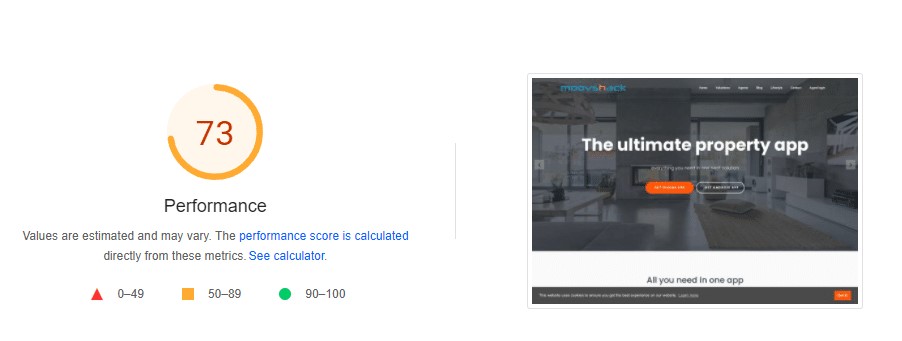
It wasn’t perfect, but the improvement was significant. We addressed the rendering problem caused by Salient. Those familiar with Salient know its page preloader feature. This feature was inadvertently blocking Google from accessing the site’s content. The reason? The site’s prolonged load time meant Google primarily detected the constant spinning wheel, largely made of JavaScript. Resolving this was a game-changer for the site. With content now visible to Google and improved load time, I shifted focus to content strategy.
Content Planning
Starting with a new domain, I aimed for queries I believed we could rank for. Initially, there were no commercial pages. My approach was straightforward: target relevant, easy-to-rank keywords related to ‘moving house’. Given our lack of content, any keyword represented a potential ranking opportunity. Our primary focus areas included:
● Types of properties.
● Legal and paperwork aspects.
● Popular locations tied to our top agent clients.
● Costs related to moving.
● Assistance with moving.
One advantage of a fresh domain is that many competitors have already paved the way. I identified content gaps in their work to exploit. To do this, I:
● Examined moving house forums for recurring questions and themes.
● Mined YouTube comments.
● Scoured Quora, Reddit, and Facebook groups for insights.
Content Planning
Starting with a new domain, I aimed for queries I believed we could rank for. Initially, there were no commercial pages. My approach was straightforward: target relevant, easy-to-rank keywords related to ‘moving house’. Given our lack of content, any keyword represented a potential ranking opportunity. Our primary focus areas included:
● Types of properties.
● Legal and paperwork aspects.
● Popular locations tied to our top agent clients.
● Costs related to moving.
● Assistance with moving.
One advantage of a fresh domain is that many competitors have already paved the way. I identified content gaps in their work to exploit. To do this, I:
● Examined moving house forums for recurring questions and themes.
● Mined YouTube comments.
● Scoured Quora, Reddit, and Facebook groups for insights.
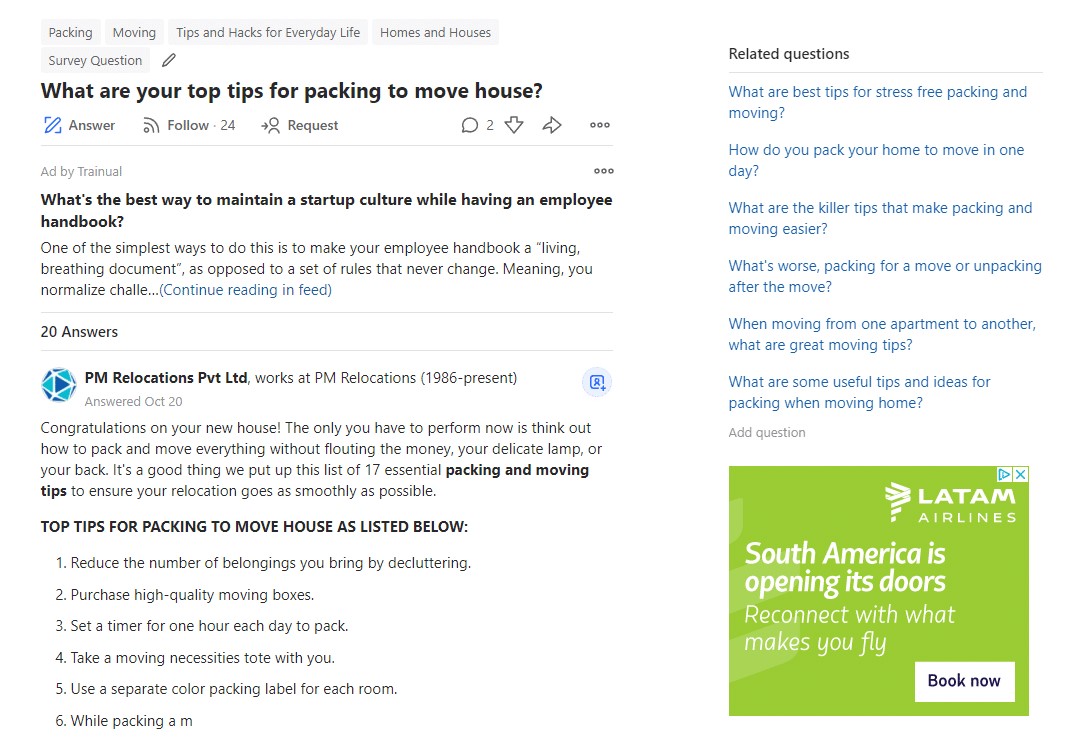
Gathering insights directly from consumers, like forums and social media, offers unique perspectives for content. Based on the data and analyzing our competitors’ content breadth, I formulated our strategy. Our approach was aggressive initially, gradually tapering off once Google recognized our content efforts. Here’s our publishing schedule and budget:
● Month 1: 30 articles
● Month 2: 30 articles
● Month 3: 20 articles
● Month 4: 10 articles
● Month 5: 10 articles
This schedule gives a glimpse into our content planning approach.
● Month 1: 30 articles
● Month 2: 30 articles
● Month 3: 20 articles
● Month 4: 10 articles
● Month 5: 10 articles
This schedule gives a glimpse into our content planning approach.
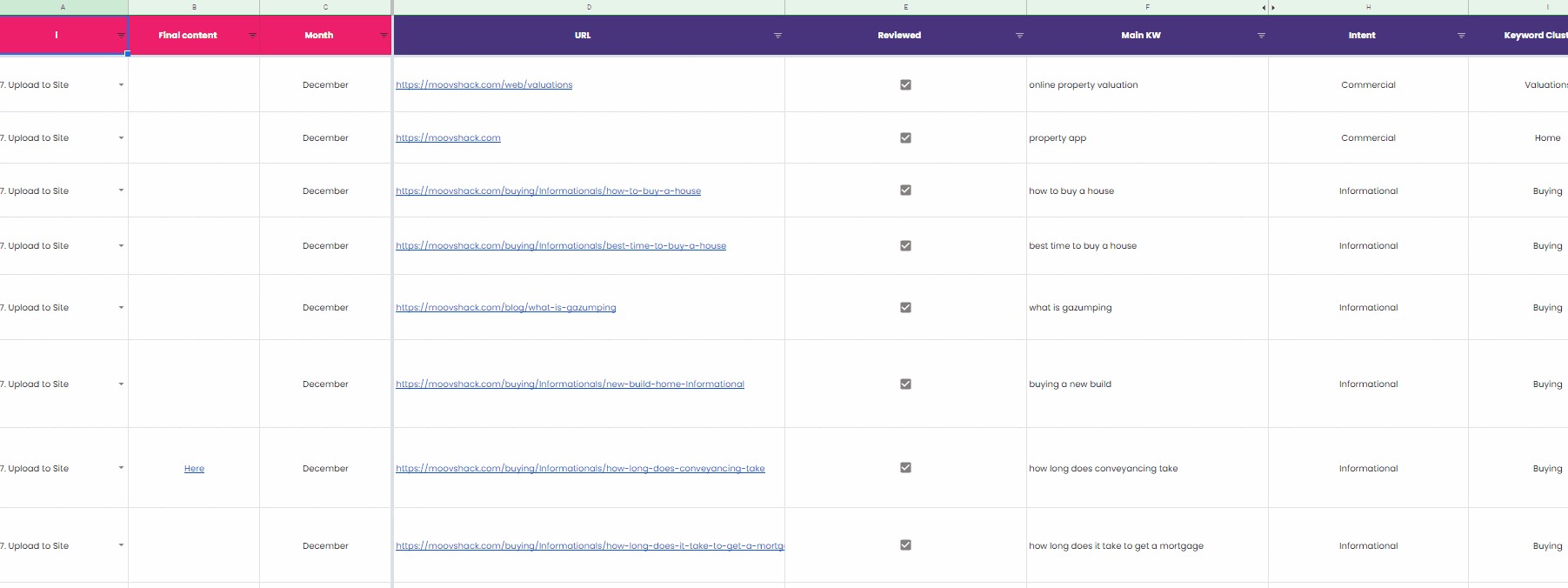
Our team consisted of two writers. While I anticipated each writer would deliver an article every other day, they exceeded expectations, providing an article daily. Thus, we had content ready for publishing every day for half the month. However, only 60 of the planned articles made the cut for our blog.
Instead of releasing articles gradually, we decided on a bulk upload approach to create a surge in website activity. By the conclusion of the first month, our traffic statistics were as follows:
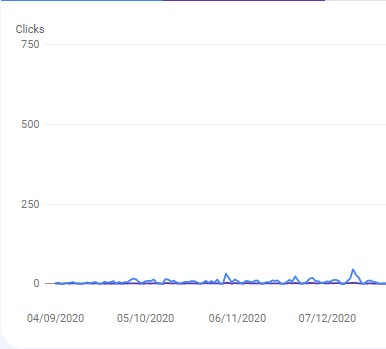
Content Budget
I’ll be candid about the campaign details, but out of respect for the client, I won’t get too specific on certain aspects. We operated on a budget ranging from £2,000 to £5,000 monthly, which covered all our plans and my fee.
To get a breakdown, you can scroll up. Given the property niche and typical SEO costs, this was a tight budget. It’s worth noting that my current fee is significantly higher, so any comparisons should take that into account.
Link Building I’ve always been wary of links in the industry, mostly due to my ethical concerns about delivering something I wasn’t sure of. There are many unreliable link providers, which is why I’ve kept my distance after some bad experiences.
For Moovshack, I decided to take matters into my own hands, even if it meant a slower process. I chose to directly reach out to websites for PR, guest posts, and roundups. In half a year, I successfully built close to 100 referring domains.
To get a breakdown, you can scroll up. Given the property niche and typical SEO costs, this was a tight budget. It’s worth noting that my current fee is significantly higher, so any comparisons should take that into account.
Link Building I’ve always been wary of links in the industry, mostly due to my ethical concerns about delivering something I wasn’t sure of. There are many unreliable link providers, which is why I’ve kept my distance after some bad experiences.
For Moovshack, I decided to take matters into my own hands, even if it meant a slower process. I chose to directly reach out to websites for PR, guest posts, and roundups. In half a year, I successfully built close to 100 referring domains.
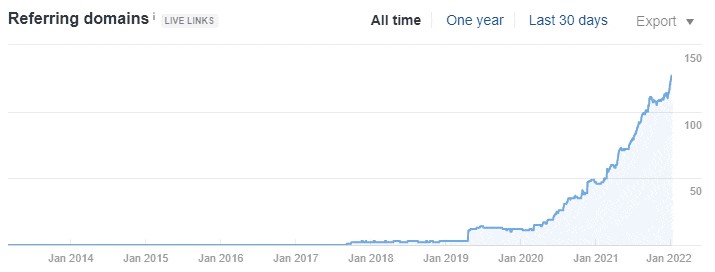
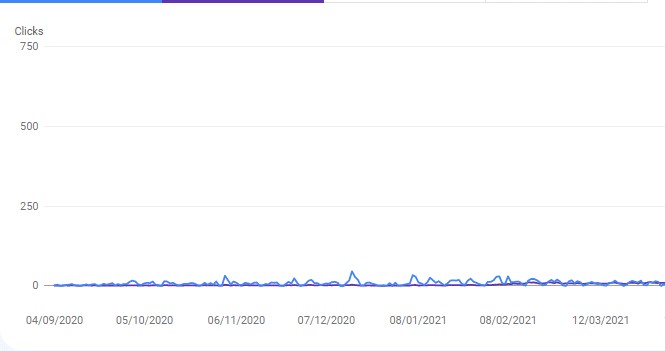
You might laugh and think my link-building approach was minimal. But delve deeper, and you’ll notice links from renowned sites like Metro.co.uk, Estateagenttoday.co.uk, and many others. My emphasis was on relevance.
While I could have easily spent client funds on generic guest posts and later faulted Google for poor results, I chose not to. Instead, my approach involved:
● Resource links.
● Expert inputs.
● Quality guest posts.
● Company features on property tech platforms.
I dedicated 2-5 hours weekly to link building, utilizing Ahrefs for target sourcing and sending out emails. My belief: Links from relevant, high-traffic sources are invaluable. Don’t get lured by providers pushing links based solely on Domain Rating. It’s misleading on its own.
Results (By The End Of Month 3)
While I could have easily spent client funds on generic guest posts and later faulted Google for poor results, I chose not to. Instead, my approach involved:
● Resource links.
● Expert inputs.
● Quality guest posts.
● Company features on property tech platforms.
I dedicated 2-5 hours weekly to link building, utilizing Ahrefs for target sourcing and sending out emails. My belief: Links from relevant, high-traffic sources are invaluable. Don’t get lured by providers pushing links based solely on Domain Rating. It’s misleading on its own.
Results (By The End Of Month 3)

Alright, hold the applause. It’s time for a reality check.
Even with the progress, I faced challenging discussions with the client about the website’s performance. Given the resources and time invested, their concerns were valid.
Remember, this site had been ignored by Google for ages. Reviving it was always going to be a marathon, not a sprint. Crawling, indexing, and rendering issues alone meant waiting at least half a year. Plus, the benefits of link-building aren’t instant.
I proposed an ultimatum to the client: if there’s no progress in the next month, we’d terminate the contract three months ahead of schedule.
Where The Magic Begins
Having done everything by the book, I was baffled when the results weren’t as expected. It’s a daunting feeling, even for a seasoned SEO professional, to question if the strategy was flawed.
Upon reviewing my approach, I pinpointed a few potential pitfalls: lack of links from the homepage to the blog, possible over-optimization of internal links, and some content that seemed overly stuffed with keywords. The content felt too mechanical and lacked the natural flow it needed.
In a move that might seem unconventional, I decided to ‘de-optimize’. I toned down the content on 30 pages where I felt our approach was too aggressive, especially when compared to competitors in the search engine results pages.
While some might argue against focusing on keyword density, I tend to trust practical results over pure theory. So, I made the necessary changes and resubmitted these pages to Google, ensuring they recognized the updates.
Finally, after all the tweaks, the website started showing signs of life.
Even with the progress, I faced challenging discussions with the client about the website’s performance. Given the resources and time invested, their concerns were valid.
Remember, this site had been ignored by Google for ages. Reviving it was always going to be a marathon, not a sprint. Crawling, indexing, and rendering issues alone meant waiting at least half a year. Plus, the benefits of link-building aren’t instant.
I proposed an ultimatum to the client: if there’s no progress in the next month, we’d terminate the contract three months ahead of schedule.
Where The Magic Begins
Having done everything by the book, I was baffled when the results weren’t as expected. It’s a daunting feeling, even for a seasoned SEO professional, to question if the strategy was flawed.
Upon reviewing my approach, I pinpointed a few potential pitfalls: lack of links from the homepage to the blog, possible over-optimization of internal links, and some content that seemed overly stuffed with keywords. The content felt too mechanical and lacked the natural flow it needed.
In a move that might seem unconventional, I decided to ‘de-optimize’. I toned down the content on 30 pages where I felt our approach was too aggressive, especially when compared to competitors in the search engine results pages.
While some might argue against focusing on keyword density, I tend to trust practical results over pure theory. So, I made the necessary changes and resubmitted these pages to Google, ensuring they recognized the updates.
Finally, after all the tweaks, the website started showing signs of life.

After four stagnant months, Google eventually acknowledged our efforts. The turning point was securing the featured snippet for ‘how to cancel your council tax’, which attracted thousands of visitors.
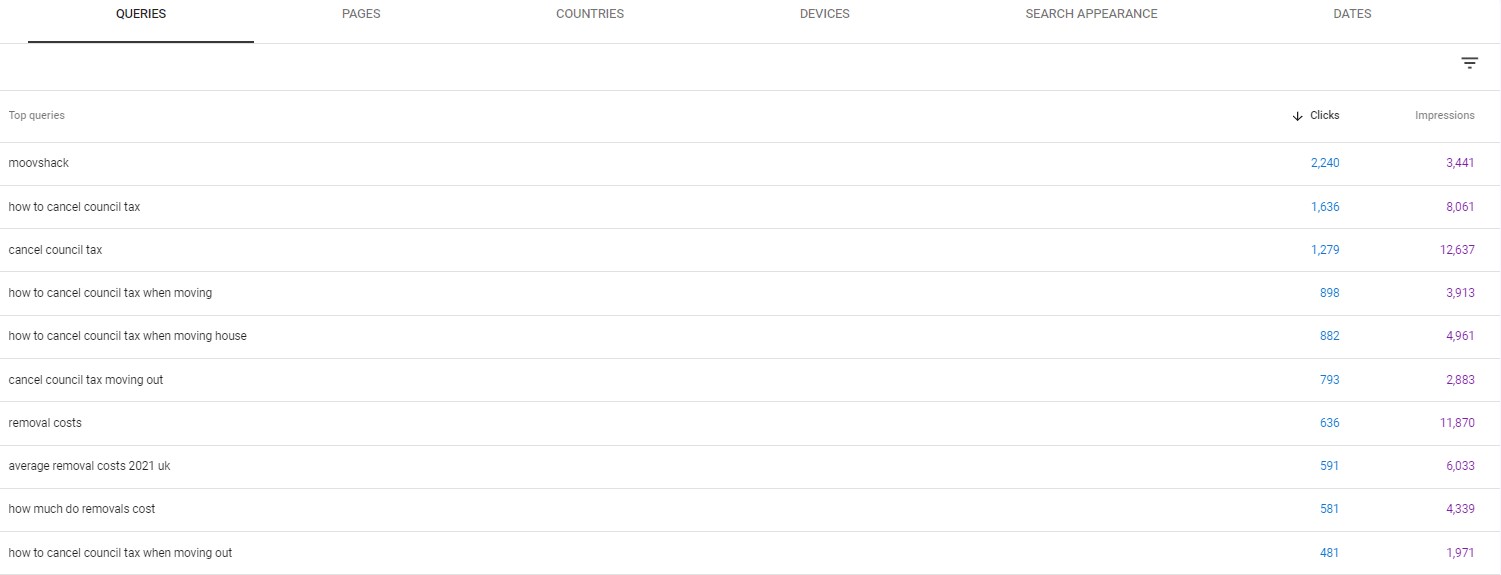
After Google recognized our site, more content began to rank. This underscores the importance of consistent SEO efforts. Had I ceased content or link-building by month 3, we wouldn’t have seen this success. SEO remains a long-term strategy, at least until AI takes over.
Final Thoughts
SEO isn’t about outdoing others, but about achieving results despite challenges. This startup now attracts 7,000 – 8,000 visits monthly, invaluable for its growth. Even with limited resources, I, alongside two writers, accomplished something significant.
If you believe that your business could benefit from the strategies and insights I’ve shared, I’d be honored to discuss how I can be of service to you. Feel free to reach out if you’re interested in elevating your digital presence. Your next success story could be just a conversation away.
Final Thoughts
SEO isn’t about outdoing others, but about achieving results despite challenges. This startup now attracts 7,000 – 8,000 visits monthly, invaluable for its growth. Even with limited resources, I, alongside two writers, accomplished something significant.
If you believe that your business could benefit from the strategies and insights I’ve shared, I’d be honored to discuss how I can be of service to you. Feel free to reach out if you’re interested in elevating your digital presence. Your next success story could be just a conversation away.
